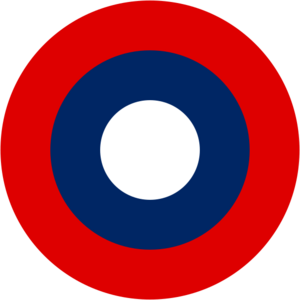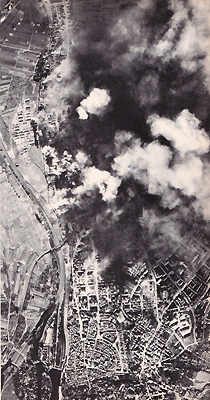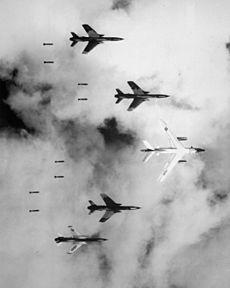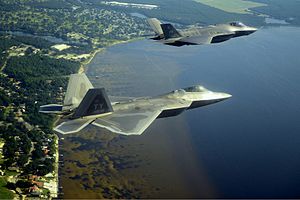History of the United States Air Force facts for kids
The United States Air Force became its own separate military branch on September 18, 1947. This happened when the National Security Act of 1947 was put into action. This new law created the National Military Establishment, which later became the United States Department of Defense. It included the Army, Marine Corps, Navy, and the brand-new Air Force.
Before 1947, the Army handled military planes used on land. The Navy and Marine Corps took care of planes used from aircraft carriers or for water landings. The Army first started a group for aviation on August 1, 1907. Over 40 years, this group changed names and jobs many times, slowly moving towards becoming its own separate service.
Here are the names of the groups that led to today's U.S. Air Force:
- Aeronautical Division, Signal Corps (1907–1914)
- Aviation Section, Signal Corps (1914–1918)
- Division of Military Aeronautics (May 1918)
- Air Service, U.S. Army (1918–1926)
- U.S. Army Air Corps (1926–1941)
- U.S. Army Air Forces (1941–1947)
The Army Air Forces were officially ended on September 26, 1947. This transferred all military and civilian staff to the new Department of the Air Force and the USAF.
Contents
How the Air Force Grew: From World War I to World War II
World War I and Early Aviation
When the U.S. joined World War I in 1917, a major U.S. aviation combat force was created. It was called the Air Service of the American Expeditionary Force (AEF). Major General Mason Patrick led this group, with Brigadier General Billy Mitchell as his helper.
These air units, some trained in France, helped the U.S. Army on the ground. They were especially important during battles like Saint-Mihiel and Meuse-Argonne. Famous pilots from this time included Captain Eddie Rickenbacker and 2nd Lieutenant Frank Luke.
After World War I ended, the AEF's Air Service was mostly shut down. In 1920, the Air Service became a regular part of the Army. In 1926, it was renamed the Army Air Corps. During this time, the Air Corps tried out new ideas. This included refueling planes in the air and developing new types of bombers and fighters.
Billy Mitchell and Air Power
Americans were very interested in flying in the 1920s and 1930s. General Billy Mitchell, a leader in the Air Service, believed that air power was the key to winning future wars. He argued that planes could sink battleships. He proved this with tests, including sinking the SMS Ostfriesland.
Mitchell strongly believed that air power should be its own separate service. He felt that pilots, who understood the new technology, should control it. He was so passionate that he was court-martialed in 1925 for speaking out. He resigned but became a public hero. His ideas helped convince the public that the Air Corps needed to be stronger.
Changes in Command and Technology
In 1935, a big step towards an independent Air Force happened. All flying units were brought together under one air commander. This group was called the General Headquarters Air Force. The Air Corps still handled supplies, airfields, and training. This effectively split the air force into two parts.
In 1937, the B-17 Flying Fortress first appeared. Three B-17s showed off their navigation skills by finding the Italian passenger ship Rex at sea. This mission showed the Air Corps could defend the coasts. It also hinted at the growing idea of strategic bombing, which meant using planes to attack important targets far behind enemy lines.
The Air Force in World War II
The Air Force truly grew up during World War II. President Franklin D. Roosevelt pushed for a much larger air force. He wanted it to focus on long-range strategic bombing. By 1941, the Army Air Corps became part of the new U.S. Army Air Forces (AAF). This made it almost independent from the Army.
By March 1942, the Army Air Forces had an equal say with the Army and Navy. It acted like a separate service in almost every way. This change helped manage the fast-growing Army Air Forces.
Major General Carl Spaatz led the Eighth Air Force in London in 1942. He oversaw the strategic bombing campaign. At first, bombers flew in tight groups, thinking their combined firepower would protect them. But this didn't work well on long missions. German Luftwaffe fighter planes shot down many U.S. bombers.
American pilots faced heavy losses during raids on oil refineries in Ploiești, Romania, and factories in Schweinfurt, Germany. The high number of lost crews forced a temporary stop to these strategic attacks in late 1943.
Protection for bombers greatly improved with the arrival of P-51 Mustang fighters in Europe. These planes had a long range and could compete with German fighters. By January 1944, the Eighth Air Force prioritized getting Mustangs. P-51 escorts began flying in February 1944. This led to big losses for the Luftwaffe. By D-Day, the German fighter threat against Allied bombers was much smaller.
In the Pacific Ocean area, the AAF provided important support to General Douglas MacArthur. His pilots developed a "skip-bombing" technique against Japanese ships. The AAF claimed to have destroyed thousands of Japanese planes and millions of tons of shipping. Also, between 1942 and 1945, hundreds of transport planes flew supplies from India to China over the Hump, a very difficult route over mountains.
The AAF also created the Twentieth Air Force to use long-range B-29 Superfortress bombers. These planes carried out strategic attacks on Japanese cities. In March 1945, General Curtis LeMay became the bomber commander. He decided to switch from high-altitude precision bombing to low-level incendiary bombings. These attacks aimed to destroy large urban areas where much of Japan's industry was located.
On the night of March 9–10, 1945, the bombing of Tokyo caused over 100,000 deaths. Incendiary bombing killed 350,000 people in 66 other Japanese cities. In August 1945, the Twentieth Air Force dropped atomic bombs on Hiroshima and Nagasaki. These attacks followed Japan's rejection of the Potsdam Declaration. Both cities were destroyed, causing huge loss of life and shock. On August 15, Emperor Hirohito announced Japan's surrender. He said the new bomb's power was "incalculable," and continuing to fight would lead to "the total extinction of human civilization."
The Cold War and Korean War Era

After World War II, the Army Air Forces were almost independent. Their leaders wanted this to be official. In November 1945, General Dwight D. Eisenhower became Army Chief of Staff. General Carl Spaatz began leading the Army Air Forces.
The National Security Act of 1947 created the United States Department of the Air Force. This made the Air Force a separate service. It officially began on September 18, 1947, when Stuart Symington became the first Secretary of the Air Force. In 1948, military leaders agreed on how to use air assets in the Key West Agreement.
The new Air Force quickly made its own identity. Army Air Fields became Air Force Bases. Personnel received new uniforms and rank symbols. The Air Force changed its old Army-style organization. General Carl Spaatz said, "No tactical commander should be subordinate to the station commander." This led to a new structure called the Base-Wing.
Under this plan, support jobs like supply, transportation, and medical care were handled by squadrons. These squadrons were part of a Combat Support Group. Combat fighter or bomber squadrons were part of a Combat Group. All these groups were assigned to a Wing, led by a Wing Commander. This way, the Wing Commander oversaw both the flying and support parts of the base.
After World War II, relations between the United States and the Soviet Union worsened. This started the Cold War. The U.S. and Soviet Union began an arms race. The U.S. expanded its military around the world. The USAF opened air bases in Europe, Japan, and South Korea.
The first big test for the USAF during the Cold War came in 1948. Soviet authorities blocked all roads and air travel to West Berlin. The USAF, along with the Royal Air Force (RAF), supplied the city during the Berlin airlift. They used C-54 Skymasters. Their efforts saved the city from starvation and made the Soviets end their blockade.
In 1948, the Women's Armed Services Integration Act allowed women to join the Air Force permanently. Esther McGowin Blake was the first woman to enlist in the Air Force on July 8, 1948.
During the Korean War, which started in June 1950, the Far East Air Forces (FEAF) were among the first to respond. They helped defend the Pusan pocket and bombed North Korea. When Chinese forces attacked in December 1950, the USAF provided air support.
The introduction of Soviet-made MiG-15 jet fighters challenged U.S. bombers. But the USAF used its new F-86 Sabre jet fighters to counter them. The USAF achieved air superiority and provided good close air support.
The Vietnam War and Beyond
The USAF was heavily involved in the Vietnam War. Bombing raids against North Vietnam began in 1964 after the Gulf of Tonkin Incident. In March 1965, a long bombing campaign called Operation Rolling Thunder started. Its goals were to break North Vietnam's will to fight, destroy its industry, and stop supplies on the Ho Chi Minh Trail.
The USAF dropped more bombs in Vietnam from 1965–68 than it did in all of World War II. While Rolling Thunder damaged the North Vietnamese economy, it did not achieve its main political and strategic goals.
The USAF also played a key role in stopping the North Vietnam People's Army's Easter Offensive in 1972. Quick deployment of fighters and bombers helped the Army of the Republic of Vietnam push back the invasion. Operation Linebacker showed that the U.S. could still influence the war with air power, even without many ground troops. The air war for the U.S. ended with Operation Linebacker II, also known as the "Christmas Bombings." These bombings helped finalize the Paris peace negotiations.
The nature of the fighting in Vietnam led the USAF to develop strong special operations abilities. This included air commandos and aerial gunships. Missions like Operation Ivory Coast deep in enemy territory and dedicated Combat Search and Rescue missions led to new ways of operating, new units, and new equipment.
USAF Operations Since 1975
The USAF updated its tactical air forces in the late 1970s. It introduced the F-15, A-10, and F-16 fighters. It also started realistic training exercises like Red Flag. The Air National Guard and Air Force Reserve also received these top-tier aircraft.
The USAF also focused on Electronic Warfare (EW) and Suppression of Enemy Air Defenses (SEAD). After a failed rescue mission in Iran in 1980, the USAF put more emphasis on working with Joint Special Operations.
The USAF provided attack, airlift, and combat support for the invasion of Grenada in 1983, the bombing of Libya in 1986, and the invasion of Panama in 1989. Lessons from these operations helped shape successful air operations in the 1990s and after 2001.
During the Cold War, satellite reconnaissance and aerial reconnaissance became very important. This led to the idea of space as a possible combat area. Air Force Space Command was formed in 1982 to handle missile warning and space operations. The internet and computer technology also led the USAF to develop cyber warfare techniques and defenses.
The Gulf War
The USAF provided most of the air power during the Gulf War in 1991. The F-117 Nighthawk stealth fighter showed its abilities on the first night. It bombed central Baghdad and avoided Iraqi air defenses. After the war, the USAF and U.S. Navy patrolled no-fly zones over northern and southern Iraq. This ensured Iraq could not rebuild its air defense.
Bosnia and Kosovo
The USAF led the NATO intervention in Bosnia and Herzegovina from 1993–96 with no-fly zones. In 1995, it carried out air strikes against the Republika Srpska. This was the first time USAF aircraft took part in a NATO mission. In 1999, the USAF led NATO air strikes against Serbia and Montenegro during the Kosovo War.
Global War on Terror
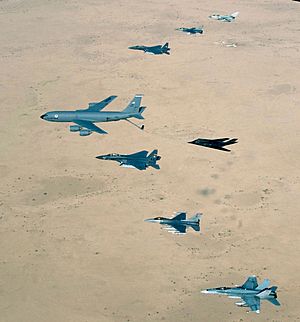
At the start of the War on Terror in 2001, the USAF was sent to Afghanistan. Bombers like the B-52 Stratofortress and B-1 Lancer attacked Taliban positions. The USAF used daisy cutter bombs, dropped from C-130 Hercules cargo planes, for the first time since Vietnam. During this conflict, the USAF opened bases in Central Asia.
The USAF was also deployed in the 2003 invasion of Iraq. After Saddam Hussein's government was defeated, the USAF used Baghdad International Airport as a base. USAF planes supported forces on the ground in Iraq. Operations in both Afghanistan and Iraq showed how useful unmanned air vehicles (drones) were, especially the MQ-1 Predator.
In March 2011, USAF jets bombed targets in Libya. This was part of a NATO-led international effort to enforce a no-fly zone. This protected people from the First Libyan Civil War as protests against dictator Muammar Gaddafi grew.
In the summer of 2014, President Barack Obama announced that U.S. Forces would return to Iraq. The U.S. Air Force carried out a large humanitarian effort to help minority groups in Iraq.
The Air Force Today
Today, the United States Air Force is the largest air force in the world. It has about 5,778 manned aircraft, around 156 Unmanned Combat Air Vehicles (drones), 2,130 Air-Launched Cruise Missiles, and 450 intercontinental ballistic missiles. The USAF has over 328,000 active duty personnel. It also has many in the Reserves and Air National Guard.
However, after many years, the USAF has its oldest fleet of aircraft ever. New tactical aircraft faced delays and cost problems. Programs to replace older bomber and tanker fleets have had to restart many times.
In 2008, an Air Force fighter pilot died when two F-15C jets crashed during training over the Gulf of Mexico. Also in 2008, the USAF chose Northrop Grumman to replace its aging air refueling tanker fleet. This was one of the largest military purchases in U.S. history.
In 2012, the USAF found that a billion-dollar investment in a new computer system had not worked well. It would need another billion dollars to get even a quarter of its planned abilities.
Also in 2012, Congress pushed back against a plan to retire several reserve squadrons. This led to a commission to figure out the right balance between active and reserve air forces.
In 2014, the USAF's strategy document said it needed both simple and advanced capabilities. It called for cutting some high-demand drones to keep older fighter aircraft.


